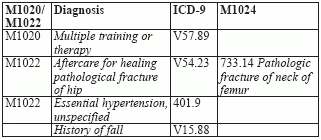Code Correctly with Falls and Fractures
Question: Our patient is a 75 year old lady who has a history of hypertension and no other medical problems. She was walking in her kitchen when she had sudden pain in her left hip and then fell. The physician confirmed this was a pathological fracture and she had an open reduction internal fixation (ORIF) of the hip. She has been admitted to home health services for rehabilitation, including both PT and OT services. How should we code for this patient?
Answer: Code for this patient as follows, says Andrea Manning, HCS-D, COS-C, BS, RN, of Manning Healthcare Group in Talkeetna, Alaska:
When a patient has a fall and a fracture, be sure to verify the etiology of the fracture with the physician, especially if it’s not specified.
You can’t list an acute pathologic fracture on a home health claim, so instead you’ll list aftercare code V54.23 and report 733.14 in M1024 to capture the case mix points.
The only exclusion to using a V54.2x aftercare code for a pathologic fracture is when the fracture is repaired using a joint replacement. In that case, you would list V54.81 (Aftercare following joint replacement). And because V54.81 isn’t in one of the two V code subcategories that trigger M1024 (V54.1x and V54.2x) you won’t earn case mix points.
Finally, include 401.9 to indicate that patient’s HTN and V15.88 to report her history of falls. Some coders have heard a myth regarding the use of V15.88 and will not use it even when appropriate. The truth is, you can include this code when the patient has had a fall and is at risk for falls.
Caution: Even though V15.88 may be used as a primary diagnosis, it is seldom the best choice as your first-listed code.

Spontaneous fractures are always considered pathological fractures. In this case, the physician verified that the fracture occurred prior to the fall and that it was a pathological fracture, so you’ll list 733.14 rather than a traumatic fracture code.

